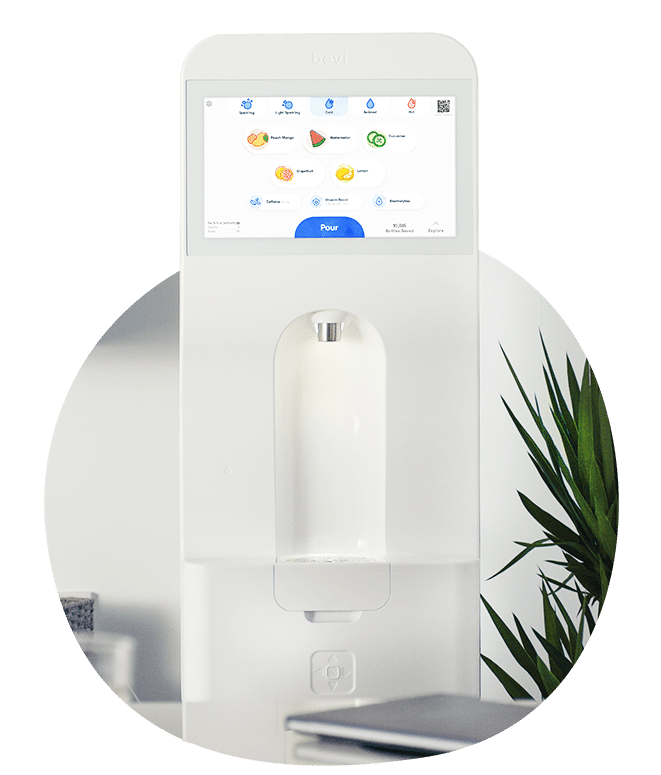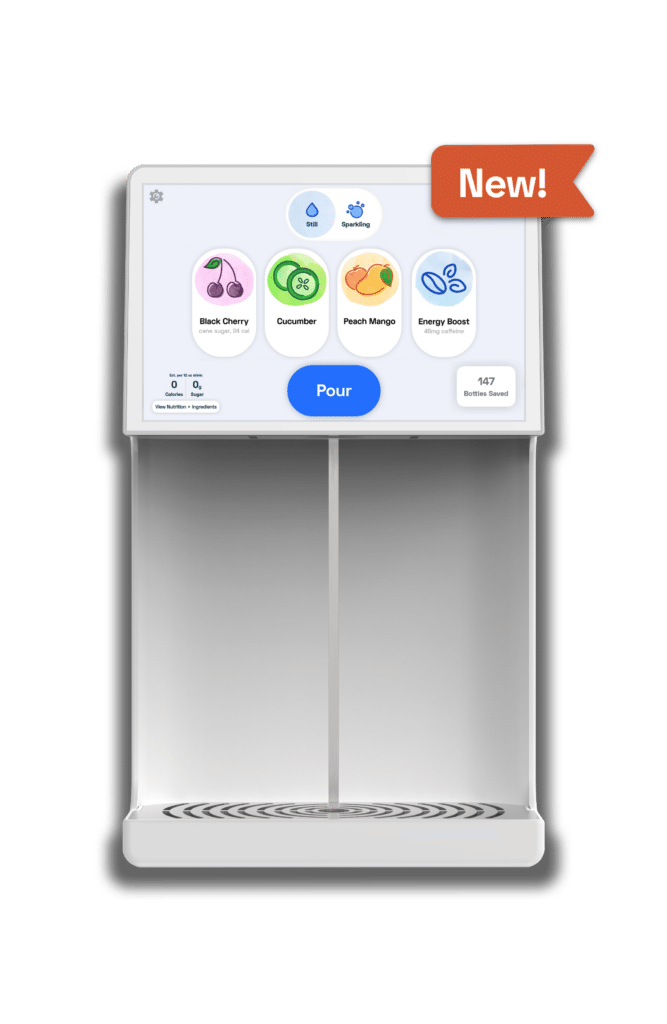Last updated April 16, 2025.
We’re entering a period in which more businesses, even those that are profitable, are cutting costs. That often means drawing the line on amenities for employees. But amenities are an essential part of getting employees interested in their work and contributing meaningfully to company goals.
So the challenge becomes: which perks at work and office amenities are really worth it for employee engagement? How do you keep your staff happy and operating expenses low at the same time?
We believe in choosing office amenities wisely. Starting at $450 per month, a Bevi Standup 2.0 machine is an investment—but it’s an investment that can easily be offset by removing some needless costs from your budget.*
Here’s how we think about it: What’re you already paying for in the office—and probably shouldn’t—that could easily go towards the cost of a Smart Water Cooler machine?

*Based on a Boston office of 25 employees dispensing about 400, 20 oz. drinks per month.
1. The ghost of subscriptions past: the ultimate operating expense worth slashing
With AI-powered technology taking the world by storm and making us more productive, Software-as-a-Service (SaaS) is becoming a larger part of the company budget. A survey by Productiv found that SaaS use steadily grew between 2021 and 2023, and reached an all-time high last year, with organizations using 371 apps on average. This chalks up to a huge company cost of almost $10k per employee.
We all know software technology can be instrumental for working better: it can help us summarize meeting notes, find coding bugs, improve our scheduling system, and write marketing content. But when you can’t keep track of all the subscriptions you’ve signed up for, it can be detrimental, and in the era of recurring payments, the ghosts of subscriptions past will come back to haunt you. The same Productiv study found that 52% of licenses were un-utilized. Expenditures on unused, underused, or duplicate SaaS tools represent a huge strain on a company’s operating expenses, and result in an annual waste of almost $135,000.
If software licensing is under your purview, make sure you’re taking time to review what software tools employees are actually using and train employees so that they are informed about the resources they have at their disposal. By streamlining your SaaS offerings, you can clear up space in the budget for a light and refreshing amenity which doesn’t involve spreadsheets. (Maybe a Bevi machine?)
A water cooler worth every penny
2. SWAG that goes on and on: a needless line-item in your operating expenses
Think ballpoint pens, notebooks, sweatshirts, T-shirts, baseball caps, tote bags, AirPod cases even—all stamped with your company’s logo. Yes, company merch can be a fun perk at work. But how many T-shirts with your company’s logo do your employees really want? Let’s be honest: Most of us have enough T-shirts and tote bags, and are already struggling to clean out our closets, so this is an operating expense that just isn’t worth it for a business.
Often given out at onboarding or around the holidays, company gifts are one tool companies can use to try and bolster employee morale and create a cohesive corporate culture. But the costs often stack up, with companies spending up to $36,000 a year on swag for employees alone, not even counting all the swag purchased for events and customers. And if leftover company merch goes unutilized, it becomes something that takes up space in a company closet or storage unit. Sometimes less really is more when it comes to gifting, and it’s better to invest in an amenity that employees will use on a daily—perhaps even hourly—basis. Maybe something spritzy and hydrating?
3. The throne of thrones: new furniture shouldn’t be a part of your operating expenses
As workplaces become more hospitality-driven, many top-tier offices look more like luxury hotels than you might remember. Gone are the days of cubicles and tiny break rooms; now there are “lounges”, quiet zones, and collaborative conference rooms. Every room needs to be furnished accordingly, with a “vibe” and amenities that rivals the comfort you’d get working from home, or the concentration you’d get in a small blank room. This results in a huge operating expenses per person: the San Francisco firm The Space Place estimates that furnishing 10,000 square feet of office space costs companies between $120,000 to $300,000, depending on whether the company chooses standard or high-end fittings.
Comfort is critical, sure, but your conference room table doesn’t need to look like a spaceship to get ideas flying. If your company is ready for a refurbishing, perhaps consider finding someone on your team who’s great at finding deals, and offer them the assignment with a bonus. January and July tend to be good times for company-wide sales, when you can keep your eyes out for special discounts. And the right pieces of second-hand furniture will come at a great discount—reducing the purchase cost by 50% to 80%—while maintaining basically the same functionality.
Many furniture suppliers are happy to offer one-on-one support, and have customer relations representatives happy to help you find the best fit for your budget. If you’re in desperate need of back support, stat, check out this list of ergonomic chairs under $300.
4. Retreats, company fly-outs, and all other kinds of travel: it’s worth it, up until a point
OK, this one isn’t exactly inside the office, but stick with us anyway. In the corporate world, company retreats and fly-outs are a great way to get employees on different teams to break out of their comfort zones, solve problems in new and innovative ways, and build camaraderie. While the idea of whisking away the entire team to a picturesque locale for brainstorming and bonding might sound like the ultimate perk, the operating expenses can quickly spiral into a budgetary black hole. From securing a venue that accommodates both work and leisure to flights, meals, transportation, and team-building activities, the expenses stack up. For instance, flying out a mid-sized team for a weekend retreat could easily run into tens of thousands of dollars, especially if international travel is involved.
Why stop there: with a typical three-day domestic business trip costing around $1,000 per employee, companies are rethinking their vendor meetings and conference plans, finding more cost-effective ways to build networks and understand client challenges.
In comparison, a Bevi smart water cooler in the office is a modest investment that keeps on giving, offering hydration and a small daily delight without the logistical nightmare and hefty price tag of a company-wide retreat. It’s also something that everyone can enjoy, not just one specific team on one specific week. Rather than escape the office, why not make a small investment in making the day-to-day office more exciting?
5. Expensive gym equipment amenities
Nothing says “we’ve made it” like an on-site office gym boasting top-tier equipment. But when you’re talking about the workplace, are machines fit for Olympians really necessary?
With employee health and wellness becoming an increasingly high priority, some workplaces are investing in tools for fitness aficionados, like the Normatec compression tools ($399-$1449) to reduce muscle soreness and the Somadome meditation pod ($14,500) for enhanced mind-body connection. These additional tools are stacked onto the more traditional equipment we already know about, like the Peloton bike – which we love, don’t get us wrong, but comes with a price tag as steep as the mountains you can climb on it ($1,445, plus an All-Access membership which comes at $44/month).
Treadmills, elliptical machines, free weights and tools take up not only a significant amount of space and require cleaning and maintenance, but also a considerable chunk of the budget. More simple measures, like subsidizing employees’ external gym memberships, can be just as effective, and can give your employees more choices.
Now that you’re pondering all those pricey office splurges, a Bevi machine looks like a far simpler investment.
Want a quote for your own smart office water dispenser? Complete the form and we’ll be in touch!
Read the latest on Bevi’s blog.
- America Unfocused: Focus Struggles at Work Inspire Bevi to Launch Focus Blend
- Blog series: The rise of today’s iconic drink brands
- Vitamin Boost: Our most popular enhancement
- Every bottle counts: Beverage industry impact report
- These London-based companies love their Bevi machines
- Owala water bottle vs. Stanley Quencher: Choosing the best stainless steel water bottle
- Poppi vs. OLIPOP: The rapid rise of better-for-you soda
- Is flavored water good for you?
- Is there bottled water without microplastics?
- 9 perks at work for a great culture






